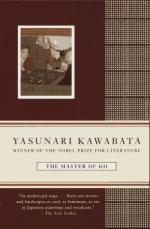|
This section contains 2,831 words (approx. 10 pages at 300 words per page) |

|
SOURCE: "The Esoteric and the Trivial: Chess and Go in the Novels of Beckett and Kawabata," in Perspectives on Contemporary Literature, Vol. 6, 1980, pp. 37-48.
In the following excerpt, Freese and Moorjani analyze the symbolism of the Go match in Kawabata's The Master of Go, and assert that the story is a movement toward the Master's death.
Yasunari Kawabata's The Master of Go, written and rewritten from 1938 until 1954, when it first appeared in book form, is not a novel in the strict sense of narrative fiction. The Japanese form of shosetsu is known to be more flexible than the Western form of the novel. In this case it mixes a chronicle, based on sixty-six newspaper installments Kawabata wrote about an actual Go match in 1938 for the Osaka and Tokyo Mainichi, with structural and stylistic elements of fiction.
Kawabata's novel begins with a note on the Master's death: "Shusai, Master...
|
This section contains 2,831 words (approx. 10 pages at 300 words per page) |

|


